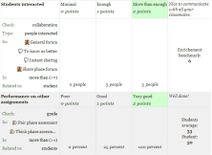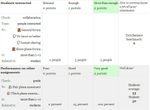Learning Analytics Enriched Rubric
Learning Analytics Enriched Rubric 1.0 (2014/02/18)
The last edition of this page was on: 2014/02/27
The Completion level of this page is : Low
The last edition of this page was on: 2014/02/27 The Completion level of this page is : Low
SHORT DESCRIPTION
The Learning Analytics Enriched Rubric (LA e-Rubric) is an advanced grading method used for criteria-based assessment. As a rubric, it consists of a set of criteria. For each criterion, several descriptive levels are provided. A numerical grade is assigned to each of these levels.
An enriched rubric contains some criteria and related grading levels that are associated to data from the analysis of learners’ interaction and learning behavior in a Moodle course, such as number of post messages, times of accessing learning material, assignments grades and so on.
Using learning analytics from log data that concern collaborative interactions, past grading performance and inquiries of course resources, the LA e-Rubric can automatically calculate the score of the various levels per criterion. The total rubric score is calculated as a sum of the scores per each criterion.
TOOL CHARACTERISTICS
Usability
Tool orientation
Data mining type
Manipulation type
IMPORT FORMAT :
EXPORT FORMAT :
| Tool objective(s) in the field of Learning Sciences | |
|
☑ Analysis & Visualisation of data |
☑ Providing feedback for supporting instructors: |
Tool can perform:
- Data extraction of type:
- Transformation of type:
- Data analysis of type:
- Data visualisation of type: (These visualisations can be interactive and updated in "real time")
ABOUT USERS
Tool is suitable for:
Required skills:
STATISTICS:
PROGRAMMING:
SYSTEM ADMINISTRATION:
DATA MINING MODELS:
FREE TEXT
| Tool version : Learning Analytics Enriched Rubric 1.0 2014/02/18 (blank line) Developed by : John Dimopoulos | 
|
SHORT DESCRIPTION
The Learning Analytics Enriched Rubric (LA e-Rubric) is an advanced grading method used for criteria-based assessment. As a rubric, it consists of a set of criteria. For each criterion, several descriptive levels are provided. A numerical grade is assigned to each of these levels.
An enriched rubric contains some criteria and related grading levels that are associated to data from the analysis of learners’ interaction and learning behavior in a Moodle course, such as number of post messages, times of accessing learning material, assignments grades and so on.
Using learning analytics from log data that concern collaborative interactions, past grading performance and inquiries of course resources, the LA e-Rubric can automatically calculate the score of the various levels per criterion. The total rubric score is calculated as a sum of the scores per each criterion.
TOOL CHARACTERISTICS
| Tool orientation | Data mining type | Usability |
|---|---|---|
| This tool is designed for general purpose analysis. | This tool is designed for . | Authors of this page consider that this tool is . |
| Data import format | Data export format |
|---|---|
| . | . |
| Tool objective(s) in the field of Learning Sciences | |
|
☑ Analysis & Visualisation of data |
☑ Providing feedback for supporting instructors: |
Can perform data extraction of type:
Can perform data transformation of type:
Can perform data analysis of type:
Can perform data visualisation of type:
(These visualisations can be interactive and updated in "real time")
ABOUT USER
| Tool is suitable for: | ||||
| Students/Learners/Consumers:☑ | Teachers/Tutors/Managers:☑ | Researchers:☑ | Organisations/Institutions/Firms:☑ | Others:☑ |
| Required skills: | |||
| Statistics: | Programming: | System administration: | Data mining models: |
OTHER TOOL INFORMATION

|
| LearningAnalyticsEnrichedRubric.jpg |
| Moodle 3.jpg |
| Learning Analytics Enriched Rubric |
| Free&Open source |
| John Dimopoulos |
| 2014/02/18 |
| 1.0 |
| http://docs.moodle.org/23/en/Learning Analytics Enriched Rubric |
| The Learning Analytics Enriched Rubric (LA e-Rubric) is an advanced grading method used for criteria-based assessment. As a rubric, it consists of a set of criteria. For each criterion, several descriptive levels are provided. A numerical grade is assigned to each of these levels.
An enriched rubric contains some criteria and related grading levels that are associated to data from the analysis of learners’ interaction and learning behavior in a Moodle course, such as number of post messages, times of accessing learning material, assignments grades and so on. Using learning analytics from log data that concern collaborative interactions, past grading performance and inquiries of course resources, the LA e-Rubric can automatically calculate the score of the various levels per criterion. The total rubric score is calculated as a sum of the scores per each criterion. |
| General analysis |
| Low |

